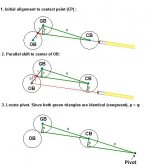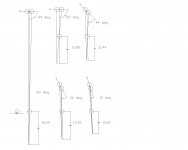Sorry to interject with the CTCP discussion. Let us talk amongst ourselves, please....Upon further thought, I believe that since the OB appears smaller the farther away it is, to infinity to exagerate, that the shift would be if parallel with reference to the OB (and not to the CB), the shift will be smaller as the OB is farther away making the bridge to CB ratio closer to 1/2 rather than 1 to 1 the distance from the OB to CB.
LAmas,
I should have put this up with the other diagrams. Just to clarify. For some desired object ball impact angle with respect to the CB-OB line of centers, the parallel offset distance ("b" in the diagrams below) doesn't change with different CB-OB separations. Its direction (orientation) changes slightly, but not much unless the balls are very, very close. This assumes that the parallel shift is a true parallel shift, of course. In other words, perspective issues don't cause a distortion, which I think is not too unreasonable.
If you accept that, the length "p" in the third diagram is then equal to the length "q." This is contingent upon the two triangles being congruent, which is true by virtue of three identical angles and a corresponding side, side "b" in fact (geometry talk).

If this catches on and you supply the dowels, I'll glue the tips on.
Jim
Last edited:

